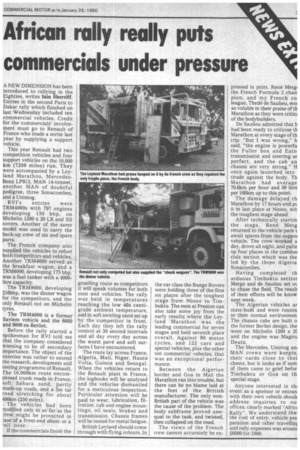African rally really puts commercials under pressure
Page 35

If you've noticed an error in this article please click here to report it so we can fix it.
A NEW DIMENSION has been introduced to rallying in the Eighties, writes lain Sherriff. Entries in the second Paris to Dakar rally which finished on last Wednesday included ten commercial vehicles. Credit for the commercials' involvement must go to Renault of France who made a sortie last year by supplying a support vehicle.
This year Renault had two competition vehicles and four support vehicles on the 10,000 km (7250 miles) run. They were accompanied by a Leyland Marathon, MercedesBenz LP913, MAN 14-tonner, another MAN of doubtful pedigree, three Sonacombes, and a Unimog.
RVI's entries were TRM4000s with 797 engines developing 130 bhp, on Michelin 1200 x 20 LX and XS covers. Another of the same model was used to carry the back-up crew of six and spare parts.
The French company also supplied the vehicles to refuel both competitors and vehicles. Another TRM4000 served as the breakfast wagon, and a TRM6000, developing 175 bhp, was a fuel tanker with a 4000litre capacity.
The TRM9000, developing 216bhp, was the dinner wagon for the competitors, and the only Renault not on Michelin tyres.
The TRM4000 is a former Saviem vehicle and the 6000 and 9000 ex-Berliet.
Before the rally started a spokesman for RVI told me that the company considered winning to be of secondary importance. The object of the exercise was rather to extend the research, development and testing programme of Renault.
The 10,000km route encom passed trunk roads in France, soft Sahara sand, partly made-up roads, and a 5m tar road stretching for about 400km (250 miles).
The .vehicles had been modified only in so far as the :.,rew might be protected in ase of a front-end shunt or a -oil over.
If the commercials finish the gruelling route as competitors it will speak volumes for both men and vehicles. The rally was held in temperatures reaching the low 40s centigrade ambient temperature, and in soft swirling sand set up by the competitor in front. Each day they left the rally control at 30 second intervals and all day every day across the worst pave and soft surfaces I have encountered.
The route lay across France, Algeria, Mali, Niger, Haute Volta, Guinea and Senegal. When the vehicles return to the Renault plant in France, the logbooks will be analysed and the vehicles dismantled for a meticulous inspection. Particular attention will be paid to wear, lubrication, filtration, cab and engine mountings, oil seals, brakes and transmission. Chassis frames will be tested for metal fatigue.
British Leyland should come through with flying colours. In the car class the Range Rovers were holding three of the first six places after the toughest stage from Niono to Timbuktu. The men at Preston can also take some joy from the early results where the Leyland Marathon was the leading commercial for seven stages and held seventh place overall. Against 90 motor cycles, and 122 cars and special vehicles, plus the other ten commercial vehicles, that was an exceptional performance.
Between the Algerian border and Goa in Mali the Marathon ran into trouble, but there can be no blame laid at the feet of the British manufacturer. The only nonBritish part of the vehicle was the cause of the problem. The. body subframe proved unequal to the task, and twisted, then collapsed on the road.
The views of the French crew cannot accurately be ex pressed in print. Rend Metgi the French Formula 2 charr pion, and my French co league, Thede de Saulieu, wet as voluble in their praise of th Marathon as they were critic; of the bodybuilders.
De Saulieu admitted that h had been ready to criticise th Marathon at every stage of th trip. "But I was wrong," h said, "the engine is powerfu the Fuller box and Eato transmission and steering ar perfect, and the cab an chassis are very strong." H once again launched into tirade against the body. Th Marathon had average 70.6km per hour and 50 litre per 100km up to this point.
The damage delayed th Marathon by 17 hours and pt it in last place at Niono, wit the toughest stage ahead.
After technically startin the stage, Rene Metg returned to the vehicle park t await spares from the suppoi vehicle. The crew worked a day, drove all night, and pulle up four places in the commei cials section which was the led by the three Algeria Sonacombes.
Having completed th arduous Timbuktu sectior Metge and de Saulieu set ou to chase the field. The result of their efforts will be know next week.
The Algerian vehicles ar state-built and were runnin in their normal environmen The chassis cabs are built o the former Berliet design, the were on Michelin 1200 x 2C and the engine was Magiru Deutz.
The Mercedes, Unimog an MAN crews were keepinl their cards close to thei chests, but it looks as if som of them came to grief befor Timbuktu or Goa on th special stage.
Anyone interested in till event as a sponsor or entran with their own vehicle shout( address inquiries to ou offices, clearly marked "Afric Rally". We understand thai the cost of entry, vehicle pre paration and other travellini and rally expenses was aroum £6000 for 1980.












































































































































